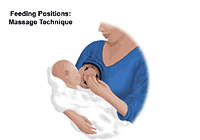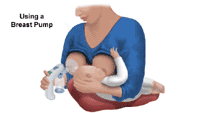How to Keep Baby Awake Andnsucking Hard at the Breast
Issues with Latching On or Sucking
Information technology's common in the first days of life for a baby to take trouble latching on or maintaining sucking at the breast. If this problem doesn't go away, more help is needed. A baby must exist able to remove enough milk from the breast through correct latch and sucking to proceeds weight. This milk removal then tells the breasts to increase or maintain milk production. If the baby doesn't go enough milk, they will have poor weight gain. Poor milk removal from the breast tin also impact milk supply.
Many things can touch on a baby'due south ability to suck and remove milk. Factors such equally prematurity, jaundice, infection, heart disease, a mother'due south medicines, and many others can impact a baby's ability to stay warning or coordinate the suck-swallow-breathe actions. Other mechanical issues that may play a role include tongue-tie or a cleft lip or cleft palate. These might direct interfere with a baby'due south ability to utilise the structures in the mouth for effective sucking.
Sometimes the cause is obvious. Ofttimes information technology's not. Just it's important to recognize the signs that a baby tin can't effectively remove milk during breastfeeding. Then the baby's healthcare provider can ensure there are no wellness or mechanical issues affecting feeding. And steps can be taken to ready the problem.
Below are some signs of ineffective sucking.
The baby who normally:
-
Doesn't wake on their own to cue for feedings
-
Cues to feed fewer than 8 times in a 24-hour period
-
Cues to feed 14 or more times in a 24-hour period
-
Latches on and then lets get of the breast repeatedly
-
Pushes away or resists latch-on
-
Falls asleep within 5 minutes of latch-on or after sucking for but 2 or iii minutes
-
Doesn't suck most continuously for the first seven to ten minutes of a feeding
-
Nurses on ane side for longer than 30 to 40 minutes
-
Feeds for more than 45 minutes without acting satisfied or full after a meal
-
Produces fewer than 3 to iv stools in 24 hours (3 to four stools per day is normal for a baby who is more than 1 week erstwhile and younger than 1 month)
-
Seems gassy or produces green, frothy stools after the first week
-
Produces fewer than 6 wet diapers in 24 hours (a baby produces vi wet diapers a day by the finish of the starting time calendar week)
-
Has problem taking milk by other feeding methods
The mother who:
-
Always has sore or bruised nipples or areola
-
Gets red, scraped, or cracked nipples
-
Oftentimes has misshapen nipples after feedings (such every bit creased or flattened)
-
Rarely or never notices chest fullness before nursing and breast softening after nursing. This is even more than likely if in that location are several hours between feedings.
-
Has more than 1 episode of plugged milk ducts or mastitis
How you can help with the breastfeeding process
When a problem with latch-on or sucking continues beyond the showtime few days after birth, information technology can exist discouraging. About babies will learn to breastfeed effectively if they are given time. But information technology'southward important to work with the baby's healthcare provider and a certified lactation consultant (IBCLC) if a baby has trouble latching or sucking. Until the issue is stock-still, there are a few things y'all tin can exercise. These will help breastfeeding progress while you brand sure your baby is getting enough to eat. E'er talk with your baby'southward healthcare provider for more data:
-
Wake the baby to breastfeed every two to 3 hours if they are sleepy and still have non mastered feeding cues.
-
Your baby likely volition practise better for some feedings. Don't be discouraged if they are too sleepy. Or if they seem to forget from feeding to feeding.
-
Some feedings will final longer than others. Your baby may need time to become going at the breast for some feeds.
-
Massage your chest toward the nipple (or use 1 hand to gently squeeze the chest) to transport milk into the baby'southward oral cavity when they are nursing. This is also helpful when your baby begins to autumn asleep at the breast too soon later on starting to feed.

-
Chart the number, corporeality, and color of urine and stools for wet and muddy diapers on a daily record until latching and sucking is meliorate.
-
Use a correctly fitted, hospital-class, electric chest pump to be sure all milk is removed. Many women will express milk past pumping for a few minutes after breastfeeding. How long you will need to continue pumping depends on how speedily your baby learns to breastfeed finer. It as well depends on how much milk your baby needs to grow across what you are providing with breastfeeding.
-
Weigh the baby oft. Or tape a exam weight earlier and afterwards a feeding. This is best washed at the office of a lactation consultant or the baby's healthcare provider with a medical-grade breastfeeding calibration.
-
Offer more calories as instructed by your baby's healthcare provider.
-
Certain breastfeeding devices or alternative feeding methods may encourage effective sucking. Or they may give your baby added diet while they are learning to breastfeed. A certain device may be good for your state of affairs. But every device also has disadvantages. To forestall bug, whatever breastfeeding device should be used with the guidance of a certified lactation consultant (IBCLC) or healthcare provider with advanced knowledge of breastfeeding. Devices that may be helpful in certain situations include:
-
Nipple shield. This sparse silicone device is centered over the nipple and areola. It encourages a better latch, more effective sucking design, and better milk intake during breastfeeding for certain babies.
-
Feeding tube system. A feeding tube system may be taped to the chest or your finger. Information technology lets the baby get boosted milk through the tube when they suck. To exercise this, a thin feeding tube is attached to a syringe and taped to your chest or your finger (finger feeding). Then yous or a helper can gently printing the plunger. This sends a few drops of milk into the baby's oral cavity if they forget to suck. Commercial feeding tube systems are also available.
-
Alternative feeding methods. At that place are also other alternative feeding methods. These will make sure that your babe gets plenty food. But they are less probable to interfere with long-term breastfeeding. These include cup feeding, syringe feeding, spoon feeding, or (eye) dropper feeding. If using a canteen, bottle nipples with a slower catamenia charge per unit are often preferred.
-
-
If whatever structural alter in your babe'southward mouth is institute, work with the healthcare provider to correct or treat it. Depending on the type of variation, this may include anything from mouth exercises to surgical handling.
Other ways to assist a babe with ineffective sucking
Other hints for the baby include:
-
Skin-to-peel contact seems to help a lot of babies with nursing. This also helps yous maintain milk production.
-
When a baby has the basic idea of effective sucking but tin can't seem to do it consistently, try pumping 1 breast while breastfeeding your infant on the other.

-
You lot may want to limit the fourth dimension of each breastfeeding session if you or your infant get too frustrated. Or if the feedings take more than 40 to 45 minutes. This will give you more time to pump and remove milk effectively. Yous may also find information technology'due south easier to be patient through the learning process. You can always express milk and requite it by an alternative feeding method.
-
You may desire to let the babe'southward begetter or other family members and friends handle alternative feedings. That manner, you won't get overwhelmed. This frees you to focus on breastfeeding, maintain pumping sessions, and savour cuddling skin-to-skin with your baby.
-
Don't throw abroad any breastfeeding device or an alternative feeding method because y'all did not similar it or it did non work when offset suggested. The device or method that did not help ane day may work dandy the next.
-
One time your baby is growing and developing correctly and their nutritive sucking ability is improving, inquire your baby's healthcare provider when you can terminate waking them for feedings and begin to wait to see if they volition demonstrate feeding cues. You will also want to know when it'southward safe to get-go decreasing supplementary feedings, if they are needed.
-
Keep thinking positively. It's normal to get frustrated and recollect your baby volition never learn to breastfeed effectively. It's normal if some days seem an eternity of breastfeeding do, alternative feedings, and breast pumping sessions. It's normal for your conviction to rise and fall. Try to continue perspective by having a sense of humor. Think about how far your baby and yous have come since their birth, not how far yous still may take to get.
-
Become support. Stay in touch with the baby's healthcare provider and a certified lactation consultant. But also contact a breastfeeding back up organization. They will accept lots of data. And they'll give y'all moral support whenever yous need it.
Medical Reviewers:
- Donna Freeborn PhD CNM FNP
- Heather M Trevino BSN RNC
- Mary Terrell MD
Source: https://www.urmc.rochester.edu/encyclopedia/content.aspx?contenttypeid=90&contentid=P02650
Belum ada Komentar untuk "How to Keep Baby Awake Andnsucking Hard at the Breast"
Posting Komentar